Mastering mixed operations: Grade 5 math worksheets
Are you ready to help your 5th graders practice and master mixed operations? Do you want them to learn the rule of performing math operations in the correct order? If you answered yes, then this is the perfect article for you! Here, you will find fantastic Grade 5 math worksheets and activities with everything you need to help your children solve mixed operations problems like a superstar.
-
Improve your math fluency with Grade 5 mixed operations worksheets.
Mixed operations are mathematical expressions that involve more than one operation, such as addition, subtraction, multiplication, division, or parentheses. For example, 3 + 4 x 5 is a mixed operation that involves addition and multiplication. In this article, we aim to help 5th Grade students improve their math fluency with Grade 5 mixed operations worksheets selected from Mathskills4kids.com.
Also, this article will explore what mixed operations are for 5th graders, why they are important to practice, and how to teach them effectively using fun and engaging activities. Also, with our free printable grade 5 math worksheets on mastering mixed operations, you can download, print and use them in your classroom or at home.
Let's get started!
-
BROWSE THE WEBSITE
-
DOWNLOAD FREE WORKSHEETS
-
-
5th GRADE MATH TOPICS
- Number sense
- Addition and subtraction
- Multiplication
- Division
- Exponents
- Number theory
- Decimals
- Add & subtract decimals
- Multiply decimals
- Divide decimals
- Fractions & mixed numbers
- Add & subtract fractions
- Multiply fractions
- Divide fractions
- Mixed operations
- Problems solving
- Ratios and rates
- Percentages
- Money Math
- Number sequences
- Coordinate graph
- Variable expressions
- Data and Graphs
- Probability and statistics
- Telling time
- Unit of measurements
- 2D figures
- Triangles & quadrilaterals
- Symmetry & transformations
- 3D figures
- Geometric measurements
-
-
Add subtract multiply divide two whole numbers word problems
 Print it...
Print it...
-
Writing and interpreting numerical expressions
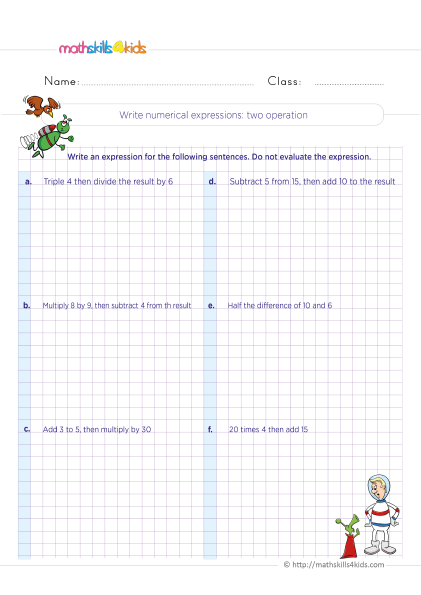 Print it...
Print it...
-
How do you evaluate numerical expressions?
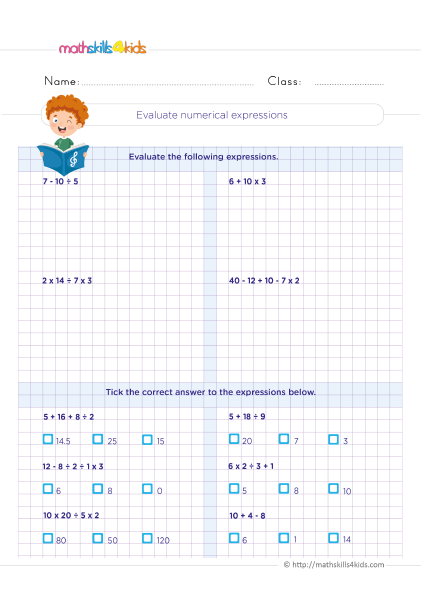 Print it...
Print it...
-
Identifying mistakes involving the order of operations
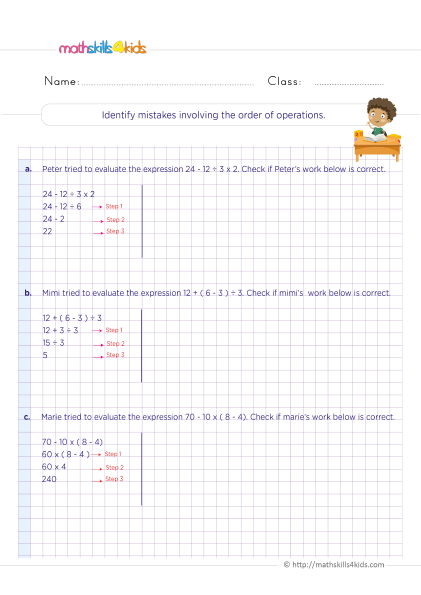 Print it...
Print it...
-
How to Add subtract multiply divide fractions with mixed numbers?
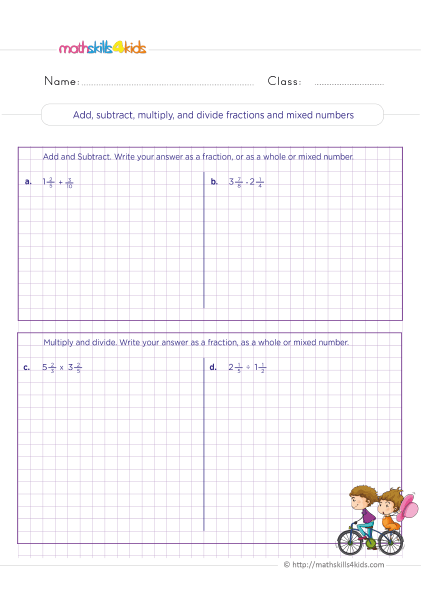 Print it...
Print it...
-
Add subtract multiply divide fractions with mixed numbers word problems
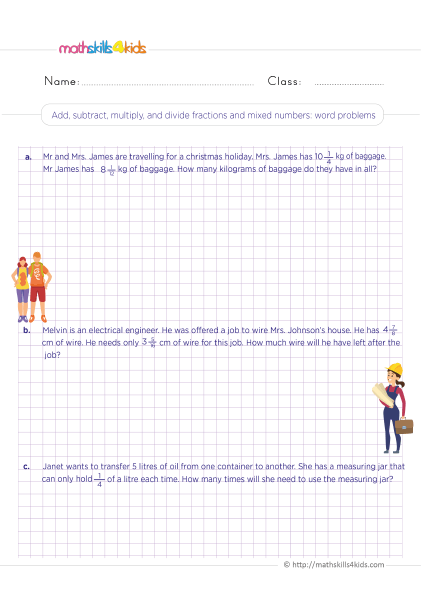 Print it...
Print it...
-
Add subtract multiply divide two whole numbers word problems
-
Buying is supporting us!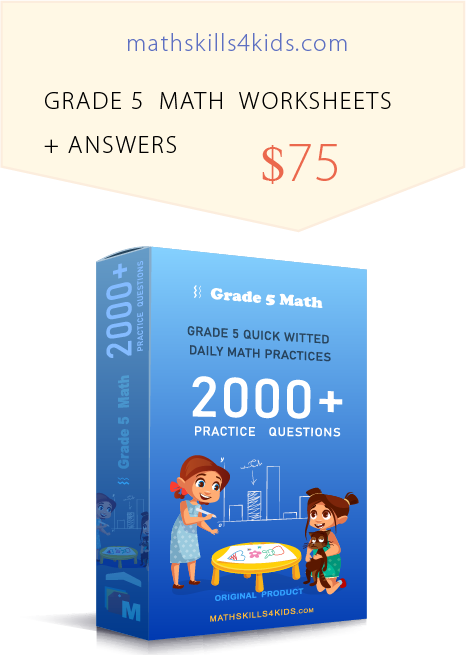
Buy Now...
-
-
What are mixed operations for 5th Graders?
Mixed operations are essential for 5th graders to master as they prepare them for more complex and challenging math problems in higher grades. Mixed operations help students develop number sense, mental math, problem-solving, and algebraic thinking skills. They also help students apply math to real-world situations, such as shopping, budgeting, measuring, and estimating.
In 5th grade, students will perform mixed operations with whole numbers, decimals, and fractions. They will also learn how to use the order of operations to evaluate expressions with multiple operations and parentheses. The order of operations is a set of rules that tells us which operation to do first in a mixed operation. The order of operations is:
- Parentheses: Do the calculations inside the parentheses first.
- Exponents: Do the calculations with exponents (powers) next.
- Multiplication and Division: Do the calculations with multiplication and division from left to right.
- Addition and Subtraction: Do the calculations with addition and subtraction from left to right.
For example, to evaluate the expression 2 + (3 x 4) - 5 ÷ 2, we follow the order of operations as:
- Parentheses: Do the calculation inside the parentheses first: 2 + (3 x 4) - 5 ÷ 2 = 2 + 12 - 5 ÷ 2
- Exponents: This expression has no exponents, so we skip this step.
- Multiplication and Division: Do the calculations with multiplication and division from left to right: 2 + 12 - 5 ÷ 2 = 14 - 2.5
- Addition and Subtraction: Do the calculations with addition and subtraction from left to right: 14 - 2.5 = 11.5
The answer is 11.5.
-
Importance of practicing mixed operation for 5th graders
Practicing mixed operations is important for 5th graders because it helps them consolidate their understanding of the four basic operations and how they relate. It also helps them develop fluency and accuracy in performing calculations with different types of numbers, such as whole numbers, decimals, and fractions.
Practicing mixed operations also helps students improve their critical thinking and reasoning skills by analyzing and interpreting different situations and problems involving multiple steps and operations. By practicing mixed operations regularly, students can build their confidence and competence in math and prepare themselves for more advanced topics in algebra and geometry.
-
How to teach mixed operations with fun and engaging activities
Teaching mixed operations can be fun and engaging if you use a variety of activities that appeal to different learning styles and preferences. Here are some examples of how you can teach mixed operations with fun and engaging activities:
- Use manipulatives and models: Manipulatives are physical objects that students can use to represent and manipulate numbers and operations, such as base-ten blocks, fraction strips, counters, dice, etc. Models are visual representations of numbers and operations, such as number lines, bar models, area models, etc.
Manipulatives and models can help students understand the concepts behind mixed operations and make connections between different representations. For example, you can use base-ten blocks to show how to add or subtract decimals by aligning the decimal points and regrouping as needed. You can also use fraction strips or area models to show how to multiply or divide fractions by finding equivalent fractions or using cross-multiplication.
- Use games and puzzles: Games and puzzles are interactive and motivating ways to practice mixed operations. They can also help students develop their strategic thinking and problem-solving skills. For example, you can use bingo cards with mixed operation expressions and call out the answers for students to mark on their cards.
You can also use crossword puzzles or word searches with mixed operations clues. You can also use board games or card games that require students to perform mixed operations or apply the order of operations.
- Use real-world scenarios: Real-world scenarios are situations that students can relate to or encounter in their daily lives that involve mixed operations. They can help students see the relevance and application of mixed operations in various contexts. For example, you can use scenarios that involve shopping, budgeting, measuring, estimating, etc.
You can also use scenarios that involve data analysis, such as finding the mean, median, mode, or range of a set of numbers. You can also use geometry scenarios, such as finding the perimeter, area, or volume of different shapes.
- Use technology: Technology can be a powerful tool to enhance the teaching and learning of mixed operations. You can use online platforms, apps, or software that provide interactive and adaptive practice and feedback on mixed operations.
You can also use online videos, animations, or simulations that demonstrate and explain mixed operations differently. You can also use online tools that allow students to create mixed operation expressions or problems and share them with others.
- Use manipulatives and models: Manipulatives are physical objects that students can use to represent and manipulate numbers and operations, such as base-ten blocks, fraction strips, counters, dice, etc. Models are visual representations of numbers and operations, such as number lines, bar models, area models, etc.
-
Free printable Grade 5 math worksheets on mixed operations
To help you teach and practice mixed operations with your 5th graders, Mathskills4kids.com has prepared some free printable grade 5 math worksheets that you can download and print from our website. These worksheets cover different topics and skills related to mixed operations, such as:
- Addition and Subtraction with Decimals
- Multiplication and Division with Fractions
- Solving Word Problems with Mixed Operations
- Applying the Order of Operations
- Evaluating Expressions with Mixed Operations
- Simplifying Expressions with Mixed Operations
These worksheets are designed to provide students with ample practice, review, and tips for mastering mixed operations in a variety of formats and levels of difficulty. They also include answer keys for easy checking and grading. You can use these worksheets as homework assignments, classwork activities, assessment tools, or enrichment materials.
-
Addition and subtraction with decimals
One of the topics that 5th graders need to master in mixed operations is addition and subtraction with decimals. Decimals are numbers with a decimal point separating the whole from the fractional part. For example, 3.14 is a decimal number with 3 as the whole part and 14 as the fractional part.
To add or subtract decimals, we need to align the decimal points and add or subtract the digits in each place value. We may also need to regroup or borrow as we would with whole numbers. For example, to add 2.3 and 4.56, we align the decimal points and add the digits in each place value as:
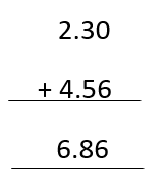
To subtract 5.67 from 8.9, we align the decimal points and subtract the digits in each place value as:

-
Multiplication and division with fractions
Another topic 5th graders will learn, and master in mixed operations is multiplication and division with fractions. Fractions represent parts of a whole or a ratio of two quantities. For example, 2/3 is a fraction that represents two parts out of three equal parts of a whole or a ratio of two to three.
To multiply fractions, we need to multiply the numerators (the top numbers) and the denominators (the bottom numbers). We may also need to simplify the resulting fraction by dividing the numerator and denominator by their greatest common factor (GCF). For example, to multiply 2/3 and 4/5, we multiply the numerators and the denominators as:
2/3 x 4/5 = (2 x 4)/ (3 x 5) = 8/15
To divide fractions, we invert (flip) the second fraction and multiply it by the first fraction. We may also need to simplify the resulting fraction by dividing the numerator and denominator by their GCF. For example, to divide 2/3 by 4/5, we invert the second fraction and multiply it by the first fraction as:
(2/3) ÷ (4/5) = (2/3) x (5/4) = (2 x 5)/ (3 x 4) = 10/12
We can simplify this fraction by dividing both the numerator and denominator by their GCF, which is 2:
10/12 = (10 ÷ 2)/ (12 ÷ 2) = 5/6
-
Solving word problems with mixed operations: Examples
Word problems are a great way to apply mixed operations skills to real-life situations. They also help students develop their logical thinking and problem-solving abilities. However, word problems can be challenging for some students, especially those involving multiple steps and operations. Here are some examples of word problems that require mixed operations and how to solve them using the order of operations.
Example 1: Anna bought 3.5 kg apples and 2.75 kg oranges. She paid $4.50 per kg for the apples and $3.25 per kg for the oranges. How much did she spend in total?
Solution: To find the total amount that Anna spent, we need to multiply the weight of each fruit by its price and then add the results. We can use parentheses to group the multiplication operations and perform the addition.
(3.5 x 4.50) + (2.75 x 3.25) = 15.75 + 8.94 = 24.69
Therefore, Anna spent $24.69 in total.
Example 2: Ben has a rectangular garden that measures 12 m by 8 m. He wants to plant flowers along the garden's perimeter, leaving a gap of 0.5 m between each flower. How many flowers can he plant if each flower needs 0.25 m of space?
Solution: To find the number of flowers Ben can plant, we must first find the garden's perimeter, which is the sum of the lengths of all four sides. Then, we need to subtract the gaps between the flowers, which are 0.5 m each. Finally, we need to divide the remaining space by the space needed for each flower, 0.25 m.
(12 + 8 + 12 + 8) - (0.5 x 4) = 40 - 2 = 38
38 / 0.25 = 152
Therefore, Ben can plant 152 flowers.
Example 3: Cindy has a jar of candies that contains 120 pieces. She wants to share them equally with her four friends and herself. However, she also wants to keep 10% of the candies for herself as a reward. How many candies will each person get?
Solution: To find the number of candies each person will get, we need to first find how many candies Cindy will keep for herself, 10% of 120. Then, we will subtract that number from the total candies and divide the result by five (Cindy and her four friends).
(10 / 100) x 120 = 12
120 - 12 = 108
108 / 5 = 21.6
Therefore, each person will get 21.6 candies.
-
Tips and tricks to help your students master mixed operations
Mixed operations can be tricky for some students, especially if they have not mastered the basic operations or the order of operations. Here are some tips and tricks to help your students master mixed operations:
- Review the basic operations (addition, subtraction, multiplication, and division) and their properties (commutative, associative, and distributive) with your students regularly.
- Teach your students how to use parentheses, brackets, and braces to group expressions and follow the order of operations.
- Use acronyms or mnemonics to help your students remember the order of operations, such as PEMDAS (Parentheses, Exponents, Multiplication/Division, Addition/Subtraction) or GEMA (Grouping symbols, Exponents, Multiplication/Division, Addition/Subtraction).
- Provide your students with plenty of practice problems that involve mixed operations with whole numbers, decimals, fractions, and integers.
- Use word problems and real-life scenarios to show your students how mixed operations are helpful and relevant in everyday situations.
- Encourage your students to check their answers using inverse operations or estimating.
- Use games, puzzles, riddles, or challenges to make mixed operations fun and engaging for your students.
-
Common mistakes and misconceptions to avoid when learning mixed operations
Mixed operations can also lead to some common mistakes and misconceptions among students, such as:
- Ignoring or forgetting the order of operations and performing the operations from left to right or in random order.
- Confusing or misapplying the properties of operations (commutative, associative, and distributive) when dealing with mixed operations.
- Making errors when performing arithmetic operations with decimals or fractions, such as not aligning the decimal points or not finding a common denominator.
- Not using parentheses or other grouping symbols correctly or consistently when writing or simplifying expressions with mixed operations.
- Not understanding or applying the correct rules when working with negative numbers or exponents in mixed operations.
- Not reading or interpreting word problems carefully or correctly or not translating them into mathematical expressions or equations with mixed operations.
To avoid these mistakes and misconceptions, teachers and parents should:
- Explain and model the order of operations and the properties of operations clearly and explicitly to their students or children.
- Provide feedback and correction when their students or children make errors or misunderstand concepts related to mixed operations.
- Reinforce and review the skills and concepts related to mixed operations frequently and systematically.
- Use different strategies and methods to teach and practice mixed operations, such as manipulatives, diagrams, tables, charts, or calculators.
- Help their students or children develop their number sense, mental math, and estimation skills when working with mixed operations.
- Guide their students or children through solving word problems with mixed operations, such as reading, understanding, planning, solving, and checking.
Bonus: Where to Find More of 5th Grade Mixed Operations Learning Resources
If you are looking for more of 5th grade mixed operations learning resources, such as worksheets, games, videos, or quizzes, here are some websites that you can check out:
- Math Playground: This website has a variety of interactive games that cover different topics related to mixed operations, such as order of operations, fraction operations, decimal operations, and more. The games are fun and challenging, providing feedback and hints. You can find them here: https://www.mathplayground.com/index_fractions.html.
- Khan Academy: This website has a comprehensive collection of videos, exercises, and quizzes that cover all the mixed operations topics for 5th grade. The videos are clear and informative, the exercises are adaptive and personalized, and the quizzes are aligned with the Common Core standards. You can find them here: https://www.khanacademy.org/math/cc-fifth-grade-math.
- Math Worksheets 4 Kids: This website has a large selection of printable worksheets that cover various mixed operations topics, such as mixed fractions, mixed decimals, mixed word problems, and more. The worksheets are organized by grade level and topic and come with answer keys. You can find them here: https://www.mathworksheets4kids.com/mixed-operations.php.
- IXL: This website has a range of online practice questions that cover different aspects of mixed operations, such as evaluating expressions, solving equations, simplifying expressions, and more. The questions are interactive and adaptive, providing instant feedback and explanations. You can find them here: https://www.ixl.com/math/grade-5.
- Math Games: This website has several fun and educational games that cover various mixed operations topics, such as mixed number operations, order of operations puzzles, decimal operations bingo, and more. The games are colorful and engaging, and they track the progress and performance of the players. You can find them here: https://www.mathgames.com/grade5.
-
-
Thank you for sharing the links of MathSkills4Kids.com with your loved ones. Your choice is greatly appreciated.
Conclusion
Mixed operations are an essential part of the 5th-grade math curriculum. They help students develop their arithmetic, logical thinking, and problem-solving skills. They also prepare students for more advanced math topics in the future. Therefore, teachers and parents need to help their students or children master mixed operations by providing them with adequate instruction, practice, feedback, and support.
We hope this article has given you helpful information and tips on teaching and learning mixed operations for 5th grade. We also hope you have enjoyed the free printable grade 5 math worksheets on mastering mixed operations provided by Mathskills4kids.com.
If you have any questions or comments about this article or Mathskills4kids’ worksheets, please feel free to contact us or leave a comment below. Thank you for reading!
